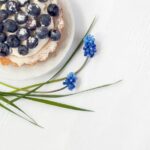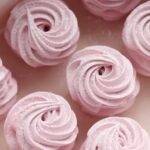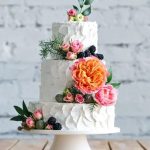The art of cake decorating has come a long way, with bakers constantly searching for new and innovative ways to make their creations stand out. One technique that has gained significant popularity in recent years is the use of flowers as a decorative element.
Whether they are real blooms or edible varieties, flowers add a touch of elegance and sophistication to any cake. In this article, we will explore the world of flowers for cake decorating and unveil the secrets behind turning ordinary cakes into stunning floral masterpieces.
A beautifully decorated cake not only looks visually appealing but also delights the taste buds. Using real or edible flowers in cake decoration is an excellent way to achieve both. Floral decorations can enhance the overall design and aesthetic of a cake, creating a focal point that draws attention and captivates the senses. In addition to their visual appeal, certain edible flower varieties can also provide a burst of unique flavors that complement the taste profile of the cake.
When it comes to choosing flowers for cake decorating, there is an abundance of options available. From delicate roses and vibrant lilies to whimsical daisies and intricate orchids, each flower brings its own charm to the table.
However, not all flowers are suitable for direct contact with food, so it’s important to know which ones are safe for consumption. Throughout this article, we will explore the types and varieties of flowers that are particularly ideal for cake decoration and edible flower options that can add beauty and flavor simultaneously.
The Importance of Incorporating Real or Edible Flowers in Cake Decorating
When it comes to cake decorating, there are endless possibilities for creating stunning and unique designs. One way to elevate your cake decorations is by incorporating real or edible flowers into your designs. The use of flowers in cake decorating not only adds a touch of natural beauty, but it also brings a sense of elegance and sophistication to your creations.
Bringing Natural Beauty to Your Cakes
The incorporation of real or edible flowers in cake decorating allows you to create beautiful and eye-catching designs that are sure to impress. The vibrant colors and delicate petals of flowers can add a pop of color and texture to your cakes, turning them into true works of art. Whether you prefer bold and colorful blooms or subtle and dainty petals, the variety of flowers available will provide endless options for creativity.
Adding Elegance and Sophistication
Incorporating real or edible flowers in your cake decorations instantly adds an element of elegance and sophistication to your creations. Flowers have long been associated with celebrations and special occasions, making them the perfect addition to a beautifully decorated cake. Whether you are creating a wedding cake, a birthday cake, or any other special occasion treat, the addition of flowers will elevate the overall look and feel, giving it an extra touch of refinement.
Freshness and Fragrance
Using real flowers in cake decorating not only adds visual appeal but can also bring freshness and fragrance to your creations. The scent of fresh flowers can waft through the air as guests enjoy their slices, enhancing the overall experience. However, it is important to ensure that any fresh flowers used on cakes are safe for consumption and have been properly cleaned.
Types and Varieties of Flowers Ideal for Cake Decoration
When it comes to decorating cakes with flowers, it is important to choose the right types and varieties that are not only aesthetically pleasing but also safe for consumption. Not all flowers are edible, and some may even be toxic if ingested. Therefore, it is crucial to carefully select flowers that are suitable for cake decoration.
One popular choice for cake decorating is the rose. Roses come in a variety of colors, such as red, pink, yellow, and white, allowing for versatile designs. These elegant and romantic flowers can be used as full blooms or individual petals to create a delicate and sophisticated look on cakes.
Another flower commonly used in cake decorating is the lavender. With its calming scent and beautiful purple hue, lavender adds a touch of elegance and uniqueness to any cake design. Lavender sprigs or individual buds can be placed strategically on the cake to provide a subtle yet visually appealing decoration.
For a more whimsical and playful look, daisies are an excellent choice. These cheerful flowers come in various colors like white, yellow, and pink. They can be used as whole flowers or individual petals on cakes to create a vibrant and joyful atmosphere at any celebration.
Other popular choices for cake decoration include violets, pansies, marigolds, chamomile, and calendula. These flowers offer different shapes, colors, and textures that can enhance the overall appearance of the cake.
Before using any flower for cake decoration, it is essential to ensure that they have not been treated with pesticides or other harmful chemicals. It is recommended to source edible flowers from reputable suppliers or grow them yourself using organic methods.
marigolds,
chamomile,
and calendula are just some examples of flowers that are ideal for cake decoration. However, it is important to exercise caution and ensure that the flowers are safe for consumption before incorporating them into your cake design.
Essential Tips for Selecting and Preparing Flowers for Cake Decorating
Selecting and preparing flowers for cake decorating requires careful consideration to ensure safety and maintain the aesthetic appeal of the cake. Here are some essential tips to follow when choosing and preparing flowers for your cake:
- Choose Edible or Non-Toxic Flowers: When using fresh flowers, it is vital to ensure that they are safe for consumption. Not all flowers are edible, and some may even be toxic. Use a reliable source, such as a reputable florist or specialty grocery store, to obtain edible flowers for your cake. Popular edible flower options include roses, pansies, violets, marigolds, and lavender.
- Avoid Using Chemical-Treated Flowers: It is crucial to use organic flowers that have not been treated with pesticides or other harmful chemicals. Toxic residues from these treatments can pose a health risk if ingested. If you grow your own edible flowers, make sure you do not use any chemical sprays on them.
- Clean Thoroughly: Before using any flower on a cake, whether freshly picked or store-bought, it is essential to clean them thoroughly. Gently wash the petals and remove any dirt or debris from the flower stems. Be careful while handling delicate petals to prevent damage.
- Remove Inedible Parts: Even if you choose edible flowers, certain parts like pistils and stamens may still need to be removed before using them on cakes. These parts can have a bitter taste or contain pollen that could stain the cake’s icing.
- Wait Until the Last Moment: To maintain freshness and prevent wilting or discoloration of the flowers, it is best to wait until just before serving the cake to place them on top. This will ensure that the beauty of both the flower arrangement and the cake remains intact.
By following these essential tips when selecting and preparing flowers for cake decorating, you can create stunning floral designs that enhance the overall appearance of your cakes while prioritizing safety and taste.
Edible Flower Varieties
Flowers not only add a visual appeal to cakes, but they can also contribute to the overall flavor of the dessert. Incorporating edible flowers in cake decorating not only makes for a stunning presentation but can also delight the taste buds of those enjoying the cake. There are several varieties of edible flowers that are not only safe to consume but also provide unique flavors and aromas that can elevate your cake to new heights.
Popular Edible Flower Varieties
There are numerous edible flower varieties available that are suitable for cake decorating. One popular option is lavender, which adds a delicate floral flavor to cakes. Its vibrant purple color provides an aesthetically pleasing contrast against any frosting or decoration.
Another commonly used edible flower is rose. Rose petals have a subtle sweet taste, making them a perfect accompaniment to creamy frostings or as a garnish on top of cakes. It’s important to note that when using roses, it is essential to remove the white base of the petal as it can be bitter.
Additionally, pansies and violas make beautiful additions to cakes with their vibrant colors and delicate appearance. These flowers have a mild minty or wintergreen flavor that complements various desserts.
Tips for Using Edible Flowers
When considering incorporating edible flowers into your cake decorations, there are some essential tips to keep in mind. First and foremost, it is crucial only to use flowers that have been grown organically and intended for consumption. Flowers from florists or garden centers may contain pesticides or other harmful chemicals.
Before using any flower in cake decorating, it’s vital to clean them thoroughly by gently washing with water and letting them air dry. This process helps remove any dirt or potential contaminants from the surface of the petals.
Lastly, make sure you carefully identify each type of flower before adding it to the cake. It’s crucial not only for aesthetic reasons but also for safety. Some flowers may have toxic properties and should be avoided, especially if you are unsure about their origin or species.
Popular Techniques for Decorating Cakes with Flowers – Fresh vs. Sugar
There are two popular techniques for decorating cakes with flowers – using fresh flowers or using sugar flowers. Each technique has its own unique advantages and considerations, allowing cake decorators to choose the method that best suits their needs and preferences.
Fresh flowers are a beautiful and natural option for cake decorating. They add a touch of elegance and a pop of color to any cake design. When choosing fresh flowers for cake decoration, it is important to select varieties that are safe for consumption and have not been treated with pesticides or other harmful chemicals. Some popular choices include roses, lavender, violets, pansies, and chamomile.
Before using fresh flowers on a cake, it is essential to prepare them properly. Remove any leaves or thorns from the stems and wash them gently in cool water.
Allow the flowers to air dry or pat them dry with paper towels before placing them on the cake. To prevent any potential contamination, it is recommended to place a barrier between the flowers and the cake surface by inserting straws or floral picks into the stems before arranging them on the cake.
On the other hand, sugar flowers offer an edible alternative that allows for more intricate designs and greater control over color choices. Sugar flowers can be made from gum paste or fondant mixed with tylose powder for added stiffness. This mixture allows the sugar flowers to dry and harden while retaining their shape and delicacy.
To create sugar flowers, begin by rolling out your chosen medium into thin sheets. Use flower cutters in various sizes to cut out individual petals, leaves, and other flower components. Assemble these pieces together using food-grade glue or royal icing to create lifelike blooms. The final step is adding detailed petal veining or coloring techniques such as dusting with edible powders or painting with edible food coloring.
Whether you choose fresh or sugar flowers for your cake decorations, each technique offers its own set of possibilities and outcomes. Experimenting with both methods can lead to stunning and unique designs that will impress any cake lover.
Step-by-Step Guide
Placing and arranging flowers on cakes can be a beautiful and captivating way to elevate the presentation of your dessert. With careful consideration and a few simple steps, you can create stunning floral decorations that will impress your guests.
- Start by selecting fresh or edible flowers that are safe for consumption and appropriate for cake decorating. Avoid using flowers that have been treated with pesticides or other harmful chemicals. If you are unsure about the safety of a particular flower, consult with a professional florist or horticulturist.
- Before placing the flowers on the cake, it is important to clean them properly. Gently wash the flowers using cool water to remove any dirt or debris. Be careful not to handle the petals too much as they can bruise easily.
- Trim the stems of the flowers to an appropriate length for your cake design. It is recommended to leave about an inch of stem so that you have enough to insert into the cake but not too much that it becomes difficult to secure.
- Choose where you want to place the flowers on your cake. Consider the overall design and layout of your cake, as well as any other decor or frosting details you may have planned.
- Insert each flower stem carefully into the cake at a slight angle, ensuring that it is securely positioned without damaging the delicate petals. You can use a small amount of buttercream frosting or royal icing as adhesive if needed.
- Arrange the flowers in a pleasing composition, taking care not to overcrowd or overwhelm the cake with too many blooms. Remember that less is often more when it comes to floral decorations on cakes.
7.Properly placed and arranged flowers can add an elegant touch to any cake design, whether it’s a simple birthday cake or an elaborate wedding cake. By following these step-by-step instructions, you’ll be able to create stunning floral arrangements that will make your cakes truly stand out.
| Step | Description |
|---|---|
| 1 | Select fresh or edible flowers that are safe for consumption and appropriate for cake decorating. |
| 2 | Clean the flowers gently using cool water to remove any dirt or debris. |
| 3 | Trim the stems of the flowers to an appropriate length for your cake design, leaving about an inch of stem. |
| 4 | Choose where you want to place the flowers on your cake, considering the overall design and layout. |
| 5 | Carefully insert each flower stem into the cake at a slight angle, ensuring it is securely positioned. |
Storage and Preservation
To ensure that your flower-adorned cakes remain fresh and beautiful, proper storage and preservation techniques are essential. Here are some guidelines to follow:
- Refrigeration: As flowers are perishable, it is important to store flower-decorated cakes in the refrigerator. However, not all flowers can withstand cold temperatures, so it’s crucial to consider the type of flowers used for decoration. Some delicate blooms may wilt or become damaged in the refrigerator, so it’s best to remove them before refrigerating the cake.
- Covering the Cake: To protect the flowers and prevent them from coming into direct contact with the cake, cover the cake with a cake dome or a large bowl. This will help maintain the freshness of both the flowers and the cake.
- Proper Placement: When placing flowers on a cake, make sure they are placed strategically so that they don’t wilt or contaminate the cake. Avoid placing flowers directly on frosting or cream as moisture from them can cause wilting or discoloration.
- Time Considerations: If you are preparing a flower-adorned cake in advance, arrange it as close to serving time as possible to ensure maximum freshness and beauty.
| Flower Variety | Storage Recommendation |
|---|---|
| Rose petals | Store in an airtight container lined with damp paper towels in the refrigerator. |
| Pansies | Gently wrap individual blooms in damp paper towels and place them in an airtight container before refrigerating. |
| Lavender | Hang lavender sprigs upside down in a cool, dry place until ready to use. |
| Nasturtiums | Place the flowers in a container of water, cover with plastic wrap, and refrigerate. |
By following these storage and preservation techniques, you can ensure that your flower-adorned cakes not only look stunning but also stay fresh for longer periods of time.
Seasonal Inspiration
In conclusion, incorporating flowers into cake decorating can add a touch of seasonality and beauty to your creations. By using different varieties of flowers, you can create stunning floral masterpieces that reflect the colors and themes of spring, summer, fall, or winter. Whether you choose real or edible flowers, it is important to select and prepare them carefully to ensure they are safe for consumption.
When selecting flowers for cake decoration, consider the specific characteristics and meanings associated with each variety. For example, vibrant tulips or daffodils can represent the arrival of spring, while sunflowers or daisies evoke a sunny and cheerful summer vibe. In autumn, you can opt for warm-toned marigolds or chrysanthemums, while winter calls for elegant white roses or delicate evergreen sprigs.
To properly place and arrange the flowers on your cakes, follow step-by-step guidelines that ensure a balanced and visually appealing composition. Take into account factors such as size, height, color palette, and overall design when deciding where to position each flower. Additionally, remember to properly store your flower-adorned cakes to keep them fresh and beautiful for longer periods of time.
Incorporating seasonal flowers into cake decorating not only enhances the aesthetics of your creations but also provides an opportunity to celebrate the natural beauty of each time of year. With some creativity and careful planning, you can transform any cake into a stunning floral masterpiece that delights both the eyes and taste buds. So why not bring a touch of spring renewal or summer vibrancy to your next cake by adorning it with beautiful blooms?
Frequently Asked Questions
What are the best flowers for cake decorating?
When it comes to cake decorating, some of the best flowers to use are edible flowers that are safe for consumption. These include flowers like violets, pansies, marigolds, and nasturtiums.
These flowers not only add a vibrant burst of color to cakes but also offer a pleasant and delicate flavor that can beautifully complement the taste of the cake. It’s important to ensure that these flowers have been grown without the use of any harmful pesticides or chemicals to guarantee their safety for consumption.
Can you put any fresh flowers on a cake?
While it may be tempting to decorate a cake with any fresh flower you come across, not all flowers are safe to be placed directly on a cake. Some flowers can contain toxins or pesticides that could pose a threat if consumed by mistake.
It is essential to know which flowers are safe before using them as decorations. Edible flowers grown specifically for culinary purposes are generally considered safe for use on cakes, provided they have been properly cleaned and prepared beforehand.
What greenery is safe for cakes?
Greenery adds an elegant touch to cake decorations, but not all types of greenery are suitable for use on cakes. One popular and safe option for cake greenery is herbs such as mint leaves, lemon balm, or rosemary sprigs. These herbs not only provide a fresh and aromatic fragrance but can also be culinary herbal additions that pair well with certain flavors in the cake.
It’s important to wash and pat dry the herbs properly before applying them onto the cake as decorations. Additionally, make sure they haven’t been treated with any harmful chemicals or pesticides before incorporating them into your design.

Welcome to my blog about home and family. This blog is a place where I will share my thoughts, ideas, and experiences related to these important topics. I am a stay-at-home mom with two young children. I hope you enjoy reading it! and may find some helpful tips and ideas that will make your home and family life even better!





